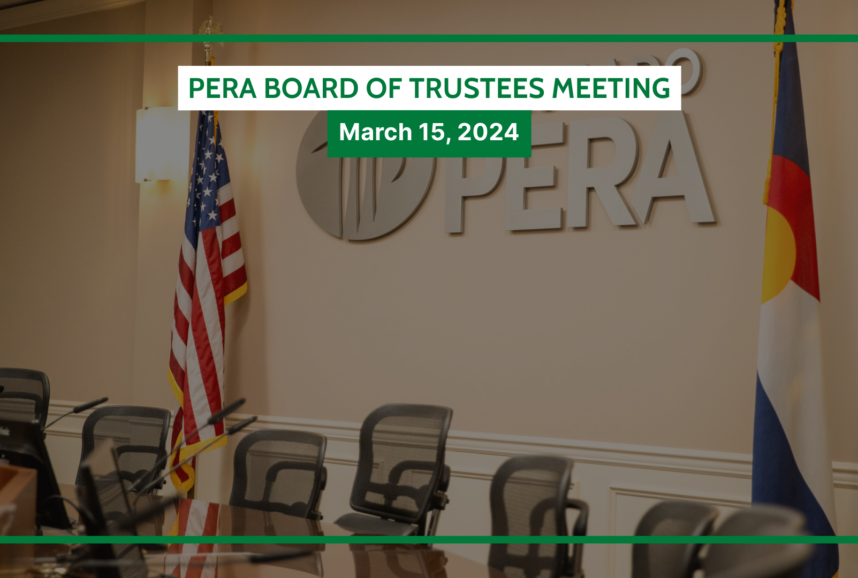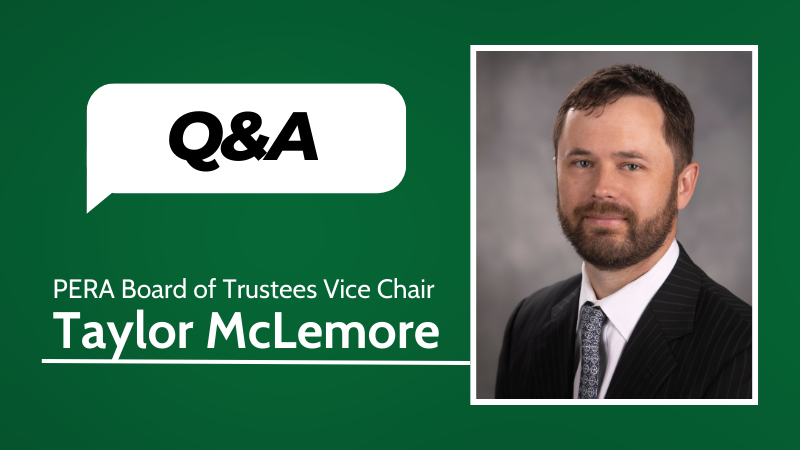PERA addresses new economic and demographic realities.
The PERA Board of Trustees met on Friday, January 20, and received updated information from their actuaries regarding the trust funds’ amortization period, or the amount of time it will take for each division trust to become fully funded. This action follows the regular and rigorous review process started late last year when the Board adopted new mortality tables to reflect longer life expectancies, and lowered the expected rate of return to better reflect anticipated market conditions.
The new amortization periods increased between 14 years to 31 years, depending on the Division. This increase is on top of the approximately 40-year amortization periods that existed at the end of 2015. The new projections show that PERA is able to pay benefits over the extended time period, but may not be able to withstand a significant market downturn (like in 2008-2009). Changes in demographics (people are living longer) and economics (expected market returns) have extended the period until PERA reaches full-funded status, increasing the risk facing members, taxpayers, and Colorado.
All major Divisions are stable, solvent, and able to pay all benefits in perpetuity. While economic and demographic conditions have changed, this is not 2009 and PERA is not running out of money.
The amortization period of the Judicial Division is much longer than other divisions. It is expected legislation will be introduced this year to address the Judicial Division’s funded status. The Judicial Division is PERA’s smallest member division with 700 active, inactive, and retired members.
The continued health of PERA is vital for the security of our members and the economic stability of communities throughout Colorado. To ensure PERA’s sustainability, the PERA Board has directed staff to embark on an effort to educate and engage a range of stakeholders on the topic of PERA’s funded status and what might be done to improve it. This effort will take place during the course of the year and there will be ample opportunities for members, policy makers, taxpayers and others to participate. More information will be forthcoming.
- See the previous PERA on the Issues article on the impact of assumption changes.
- Stakeholder Outreach Agenda
Important terms for understanding PERA’s amortization period:
- Amortization period – the time it will take to achieve 100 percent funded status.
- Solvent – the trusts have enough money to pay benefits throughout the amortization period.
- Insolvent – the trusts are projected to be depleted in the future.
- Exhaustion – same as insolvent; the trusts are projected to be depleted in the future.
PERA on the Issues posts are written and compiled by the staff of Colorado PERA under the direction of Executive Director Greg Smith and the PERA Board of Trustees. We encourage you to comment with your thoughts and feedback.
Trust fundA fund in which money and/or other assets are held and managed by trustees on behalf of plan participants. PERA maintains trust funds for each of its Defined Benefit Plan divisions (State, Local Government, School, Denver Public Schools, and Judicial).AmortizationThe act of paying down debt or liabilities over time.AmortizationThe act of paying down debt or liabilities over time.





It’s not hard to see where the board is going with this-another “shared sacrifice” is in the offing. As someone who supported the COLA cut in 2010, hearing this is a little frustrating. As a former PERA ambassador, I can tell you that a number of my retired friends only accepted SB 1 grudgingly. Now we are probably facing a second round of benefit cuts in 2018, only a few years from asserting that SB 1 was “working”.
For starters, I would like to see some candor from the board on what it, and the actuaries feel is a comfortable rate of return over the next 10 to 15 years. From what I hear from individuals who manage money, 7.25% is probably too high, so to base legislation on this figure would merely be another short-term fix. This is one member who is tired of short-term fixes.
You mention the concern over another market decline such as 2007-2008 and the impact it would have on the fund. Given that we had two major bear markets last decade, I’m surprised that this concern is surfacing now. Why wasn’t this considered when SB 1 was being written?
Pete, the new lower assumption of 7.25% doesn’t fix anything. It makes it worse, and gives politicians an false excuse to mess with benefits again. Any money manager that thinks 7.25% long term is too high, is not a money investor like PERA is. PERA’s 20 year return is 7.6% and the 35 year return is 9.5%. That doesn’t include the anticipated great return for 2016, which will bring those numbers up. PERA’s consultant recommended keeping it at 7.5%, but the Board lowered it, which made the “time to full funding” increase (that’s bad). I’m afraid a “short term fix” is coming, that isn’t necessary, based on the Board’s decision to unnecessarily lower the return assumption. That’s what I call self inflicted pain.
Please consider returning the investment return assumption to 7.5%. Reducing it was a mistake, based on long term return history, and 2016 returns. This is a long term investment and the investment return assumption should be long term as well.
Mark,
Do you know which “consultant” recommended holding the rate of return at 7.5%?
As to whether we use 7.5%, 7.25% or some other number, I’m not so sure the next thirty years can match the type of returns that 1987-2016 era produced. That may be one reason the board took a cautious approach. That said, I understand Walker Stapleton was instrumental in the decision to lower the rate to 7.25% and we know what he thinks of PERA. The thought of him becoming Governor in 2019 should give every one associated with PERA many a sleepless night.